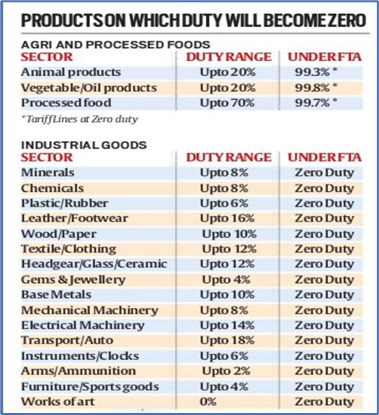Why in News?
India and the UK signed a Free Trade Agreement (FTA) after nearly three years of negotiations. The agreement reduces tariffs on 90% of goods.
The deal aims to boost trade, investment, job creation, and innovation. It comes at a time of global trade uncertainty and marks a major economic collaboration between the world’s fifth and sixth largest economies.
What’s in Today’s Article?
- Background: From "Diwali Deadline" to Final Agreement
- Key Highlights of the UK-India Trade Deal
- Reasons Behind the Push for the Deal
- Key Issues During Negotiations
- Beyond Trade: A Platform for Wider Collaboration
Background: From "Diwali Deadline" to Final Agreement
- The FTA was first targeted for completion by Diwali 2022 during British PM Boris Johnson's India visit, where he called Modi his “khaas dost.”
- Despite missing the initial deadline, the agreement was finally achieved in 2025, marking a major milestone.
- UK First Among Western Trade Partners
- The UK beat the US and EU in sealing an FTA with India — a strategic win for both nations.
- This puts India in a stronger position for ongoing trade talks with Washington and Brussels, as the UK deal becomes a benchmark for future agreements.
Key Highlights of the UK-India Trade Deal
- Trade Expansion:
- The deal is projected to increase annual bilateral trade by £25.5 billion from 2040 onward.
- In 2024, UK-India trade stood at £42.6 billion, with UK exports at £17.1 billion and imports from India at £25.5 billion.
- India ranked as the UK’s 11th-largest trading partner in 2024.
- Tariff Reductions and Market Access
- India’s Gains:
- 99% of Indian exports to the UK will enjoy zero-duty access.
- Boost for labour-intensive sectors: textiles, marine products, leather, footwear, sports goods, toys, gems & jewellery, engineering goods, auto parts, and organic chemicals.
- UK’s Gains:
- India to slash duties on 90% of tariff lines, with 85% becoming fully tariff-free within 10 years.
- Lower Indian tariffs on whisky, medical devices, advanced machinery, and lamb to make UK exports more competitive.
- Major Sectors Benefitting:
- Alcohol: Tariffs on whisky and gin will drop from 150% to 75% initially, reaching 40% by the tenth year—boosting the UK’s Scotch whisky exports.
- Automobiles: India will cut auto import tariffs to 10% under a quota system (down from over 100%).
- Other Goods: Reduced tariffs for British exports such as cosmetics, aerospace components, lamb, medical devices, salmon, electrical machinery, soft drinks, chocolate, and biscuits.
- Services and Workforce Mobility:
- The deal includes increased quotas for Indian workers to take up employment in specific sectors in the UK, enhancing labour mobility and service trade cooperation.
- Indian workers in the UK will receive a three-year exemption from social security payments, reducing financial burden and improving mobility opportunities.
Reasons Behind the Push for the Deal
- Supply Chain Disruptions & China Diversification:
- The COVID-19 pandemic exposed the vulnerabilities of global supply chains overly reliant on China.
- Western countries, including the UK, sought to implement a ‘China-plus one’ strategy—diversifying supply chains by partnering with countries like India.
- Post-Brexit Market Realignment
- After Brexit, the UK lost access to the EU’s Single Market.
- India, with its large and growing consumer base, emerged as a critical alternative to offset this economic gap.
- Economic Pressures in the UK
- The UK has been grappling with a cost-of-living crisis.
- The FTA is viewed as a timely economic boost and a political win for PM Keir Starmer, who assumed office in July 2024.
- India’s Shift from RCEP
- In 2019, India opted out of the China-led Regional Comprehensive Economic Partnership (RCEP), increasing the urgency to find alternative trade alliances like the UK.
Key Issues During Negotiations
- Limited Trade Gains for India
- According to the Global Trade Research Initiative (GTRI), many Indian exports already benefit from low or zero tariffs in the UK, so the FTA’s impact on trade volume may be limited.
- Services and Work Visas
- India prioritized better access for its service professionals, particularly in IT and healthcare.
- However, immigration remains a sensitive issue for the UK post-Brexit.
- Eventually, only about 100 new work visas per year for Indian professionals were agreed upon.
- Carbon Tax Dispute
- The UK’s proposal to impose a carbon tax on metal imports (based on emissions) raised concerns for Indian exporters, particularly in steel and aluminum.
- Negotiations were needed to address the potential impact on India’s competitiveness.
Beyond Trade: A Platform for Wider Collaboration
The FTA is seen as a foundation for deeper cooperation in sectors such as: Defence and security; Critical technologies; Education; Tourism and Indian diaspora engagement.
An Indian official aptly remarked: “The FTA is the floor, not the ceiling.”










